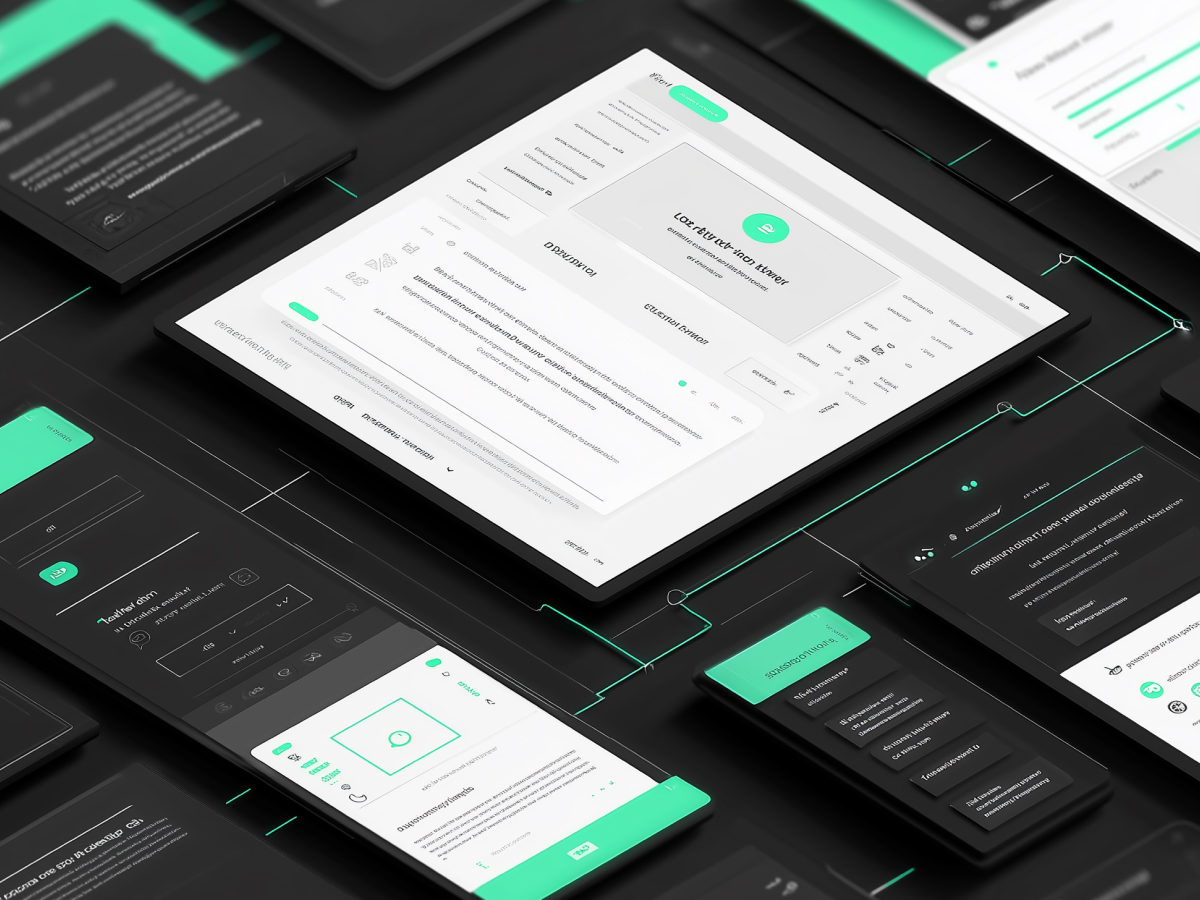Adaptive UIs improve user experience
The key to meaningful user experience today is relevance. People don’t want more features, they want the right ones, delivered instantly and without friction. Adaptive User Interfaces (AUIs) solve this. They behave intelligently based on who is using them, what device they’re on, and what their goals are.
An adaptive UI reshapes itself using real-time data. If a user is on a tablet instead of a desktop, the layout adjusts. If they’re logged in under a new account, the interface offers guidance instead of complexity. If a power user logs in, the interface opens up deeper functionality. All of this happens without the user needing to ask. That’s the kind of invisible performance improvement we need more of in software.
This kind of personalization increases user engagement, retention, and productivity. By tailoring just-in-time information and eliminating noise, we create space for speed and control. That’s measurable value.
For businesses, this means better data throughput, higher task completion rates, and reduced churn. Standard interfaces can’t do that, because they treat everyone the same. And in business, that’s just inefficient.
Adaptive UI means shaping precise use experiences that scale. You’re responding in real time based on real behavior. So, while the initial product may take longer to build, the compound impact over time, on engagement, conversion, and support reduction, is exponential.
Cross-platform adaptive UIs
Compose Multiplatform simplifies the challenge of building consistent, adaptive experiences across devices. Whether your users are on Android, macOS, Windows, or Linux, this toolkit helps you design interfaces that adapt dynamically, but with a single codebase. It’s scalable, efficient, and eliminates a huge amount of manual configuration normally required across platforms.
This matters because users no longer stick to one device. They start on a phone, continue on a tablet, and sometimes finish tasks on a desktop. Compose Multiplatform anticipates this shift. It uses responsive layout systems that adjust automatically to screen sizes and resolutions, keeping functionality intact. Your teams no longer need to redesign or maintain separate interface logics for each platform.
From a leadership perspective, this means reduced technical debt, faster time-to-market, and fewer platform-specific bugs. You’re investing in fewer resources to cover more ground. With the increased stability and flexibility that Compose provides, teams can allocate more time to improving experience quality rather than resolving platform inconsistencies.
It’s also worth highlighting that this tool is backed by JetBrains and Google, meaning strong community support, ongoing feature development, and alignment with modern coding standards. If your roadmap depends on scaling adaptive features fast, Compose Multiplatform is worth prioritizing. It streamlines adaptive UI creation without compromising the complexity or customization serious products need.
CompositionLocalProvider simplifies management of information in adaptive UIs
Consistency is essential when designing adaptive user interfaces across complex applications. That’s where CompositionLocalProvider makes a tangible impact. It provides a structured way for developers to make key global data, like screen size, theme colors, or user preferences, accessible across all UI components, without passing values explicitly through each layer of the interface.
This improves code clarity and makes large-scale UI development more manageable. When your system needs to render responsive elements reactively, based on real-time environmental inputs, CompositionLocalProvider serves as a centralized mechanism to distribute that context fluidly. It removes redundancy in logic and reinforces uniformity in behavior across the interface, which drives reliability.
For organizations, this means reduced engineering overhead and faster iteration cycles. Your teams don’t waste time rewriting logic for every new component. Instead, they build once and distribute consistently. It brings a more maintainable architecture, which supports long-term scalability.
Systems built with centralized context handling are easier to test, easier to debug, and faster to onboard new engineers into.
The value here is disciplined infrastructure that reliably supports adaptive behavior at scale. For leaders prioritizing high UX standards with lean development processes, adopting CompositionLocalProvider is a practical move that earns back time and reduces avoidable rework.
Breakpoints and window size adaptation are key
A core part of delivering a useful adaptive interface is ensuring it behaves correctly across different screen sizes. That’s what breakpoints solve. They define structured thresholds, COMPACT, MEDIUM, and EXPANDED, that trigger changes in layout, font size, spacing, and visual structure, depending on the width of the user’s display.
These breakpoints are engineered to align the UI with the device in use, whether that’s a small mobile screen, a tablet in landscape mode, or a large desktop monitor. Developers can define distinct behavior and layout logic for each category. This makes the interface predictable, accessible, and relevant no matter where or how it’s accessed.
For companies deploying products across device classes, this approach keeps the customer experience consistent without duplicating work. You design responsive behavior once for each breakpoint, and that logic scales to thousands or millions of users. It minimizes surprise and maximizes usability.
From a business standpoint, this reduces churn and lowers support ticket volume. If users can interact seamlessly across environments, you protect the customer journey, start to finish. There’s also the performance angle. Interfaces that adapt based on clean breakpoint logic tend to load faster and render more efficiently, especially on lower-end hardware.
For executives focused on reach, revenue, and retention, breakpoints are a performance lever. They make sure the digital front-end of your business meets users where they are, physically and behaviorally, with no loss in clarity or function. That’s critical if you’re serious about scaling globally.
Adaptive UIs improve performance and personalization
One of the strongest cases for investing in adaptive user interfaces is how well they handle performance and personalization, both tuned to the device in use. Instead of loading everything for everyone, adaptive UIs prioritize content based on screen size, user intent, and technical capacity like bandwidth or processing power.
This matters particularly for mobile users operating in constrained environments, low connectivity, limited memory, or small displays. An adaptive UI detects these constraints and delivers an optimized experience by loading only essential content and scaling visual components appropriately. The result is faster response times, less battery drain, and a more relevant experience.
From a personalization standpoint, the interface also aligns with user goals. Someone browsing casually is shown simplified navigation and minimal data. A user returning to complete a task or make a purchase can be presented with enhanced options and contextual information. All of this happens in real time, which prevents interruption and anticipates need.
Executives should view this adaptability as a capability multiplier. It smooths out inconsistent user flows, reduces infrastructure load per user, and helps the product deliver higher value per session. For companies, this translates into higher engagement, improved conversion, and lower abandonment.
Adaptive UIs make sure your interface uses minimal resources while delivering predictable, relevant interactions, tailored to each device and user in the moment. It’s a practical form of intelligence built directly into the experience.
Key benefits of adaptive UIs
Adaptive user interfaces do more than respond to screen sizes, they intelligently tailor the experience to meet user expectations, skill levels, and accessibility needs. This ability to personalize the interface in real time leads to higher user satisfaction and better task completion rates.
Users interact with systems differently depending on their familiarity with the product. Adaptive UIs can simplify or reveal advanced features accordingly, showing entry-level users clean, uncluttered screens while offering detailed control to proficient users. This selective presentation removes unnecessary obstacles and increases clarity, which is critical for efficiency.
Accessibility is another essential benefit. Adaptive UIs can incorporate features that support users with disabilities, adjusting font sizes, adding voice controls, or simplifying navigation structures. The result: interfaces that are inclusive without being separate or limited. Supporting diverse users with tailored experiences increases usability across the board.
For executives, the key takeaway is that adaptive design directly reduces friction in digital workflows. When users can act without frustration, because the experience is intuitive, responsive, and clearly aligned with their goals, they accomplish more, stay longer, and return more often. That translates into stronger engagement metrics and lower support costs.
Pair this with personalization grounded in behavioral signals, and adaptive UIs become high-leverage assets. Done right, the interface becomes a natural extension of each user’s intent, and that pays off across every operational layer of the business.
Challenges in adaptive UI design
While adaptive UIs offer clear advantages, their implementation comes with real challenges. Developing these systems requires tight coordination between design, engineering, product management, and user research. It’s a structural shift in how an interface is built and maintained.
One major challenge is cost. Adaptive UI development demands more up front, more planning, more testing across devices and user types, and more nuanced behavior logic. Many companies hesitate to commit these resources, especially when time-to-market is a constraint. But skipping the investment often leads to rigid solutions that underperform as user expectations evolve.
There’s also increased technical complexity. Adaptive systems rely on real-time inputs about device context, behavior, and user intent. Managing that data accurately, determining what to adapt and when, and ensuring stability across user sessions requires precision. That means a higher standard of software engineering and QA discipline throughout the build process.
Another issue is balance. The more adaptive a UI becomes, the greater the risk of making users feel removed from control. Over-automation can create confusion when users don’t understand why the interface is behaving a certain way. Transparent behavior is essential. Automation should simplify, not obscure.
For executives, the message is clear: this is a strategic build. It won’t be fast, and it won’t be cheap. But the outcome—systems that scale intelligently, adapt in real time, and improve over time, is measurable and valuable. The payoff comes in reduced support effort, increased user satisfaction, and stronger alignment between product capability and customer need.
Move forward with clarity. Design adaptability into your roadmap, but do it with full awareness of the cost, complexity, and staffing required. Shortcuts don’t build trust. Well-executed adaptive UIs do.
Best practices for adaptive UI design
Building a successful adaptive UI comes from aligning the interface with user behavior, knowledge level, and real-world context. To make an interface truly adaptive, the system must respond to who the user is, what they know, and where or how they’re interacting.
Start with intelligence around user familiarity. New users interact differently than experienced ones. Interface behavior, depth of available features, and visual complexity should adjust accordingly. Tailoring UI density and tool access based on user role or experience improves usability and reduces confusion and accelerates engagement.
Context also matters. Adaptive UIs should consider factors such as location, time of day, connectivity conditions, or even ambient noise (when relevant to device capabilities). This enables adjustments to content relevance, interaction types, and feedback mechanisms. For example, subtle changes to interface tone or pacing support smoother interaction under varying conditions.
Integrating biometric authentication improves both security and personalization. A system that identifies the user and dynamically loads their preferences, font size, layout settings, accessibility modes, is far more efficient and secure than static profiles. It’s frictionless personalization with real operational benefit.
Elements like micro-interactions and dynamic content rendering also drive better outcomes. Real-time feedback, visual cues, status indicators, or progress visuals, guides the user through key actions without extra instruction. Dynamic rendering ensures that systems react appropriately to live input, keeping the interface lean but responsive.
From a leadership perspective, these best practices are low-friction interventions with high returns. They reduce waste in design iterations, boost performance across devices, and lower user abandonment. More importantly, when deployed intentionally, they turn routine interactions into intuitive, intelligent workflows, speeding up decisions and reducing support demand.
Designing for adaptability means engineering flexibility into the system, so it can respond meaningfully to change, without requiring constant rework. Stability and personalization should operate in sync, and these practices make that possible.
Multiple design and development tools support adaptive UI creation
Adaptive UI development is supported by a growing set of specialized tools that streamline the process from concept to execution. These tools help teams design, prototype, and ship adaptive experiences faster, without compromising consistency or performance.
Google’s Flutter remains one of the most widely adopted frameworks for building adaptive interfaces across platforms. It uses a single codebase to deploy across iOS, Android, web, and desktop, significantly reducing development time. Its widget-based architecture makes it easier to define responsive elements that adapt to screen size and user behavior.
Figma is another critical resource, especially for high-fidelity design with collaborative workflows. Teams can create responsive design systems, test layouts across breakpoints, and hand assets directly to engineers. The live collaboration feature simplifies designer-developer sync and ensures fewer misaligned implementations.
Sketch is particularly useful for macOS teams focused on responsive visual design. It offers powerful layout tools and third-party plugin support, which can be extended for performance testing and adaptive prototyping. Zeplin bridges the gap between design and engineering by generating specs and UI assets automatically, minimizing the risk of implementation errors.
For rapid prototyping, tools like Marvel and Uizard allow teams to test adaptive flows and interaction logic early in the process. They cater to teams that prioritize speed and user feedback without requiring deep technical knowledge. Origami Studio, developed by Meta, supports advanced interactions and rich motion logic, enabling teams to simulate adaptive behavior before development begins.
Low-code and no-code tools are also advancing. They let non-technical teams build and test adaptive experiences using configuration rather than raw code. While these platforms won’t replace fully custom implementations, they significantly lower the barrier to experimentation and user validation.
For executives, this tool ecosystem is a force multiplier. It increases the velocity of interface improvement and shortens the time between concept and delivery. More importantly, it allows companies to standardize design workflows while staying flexible enough to react to market and user changes.
The takeaway is clear: adaptive UI creation no longer requires building from zero. With the right tools, teams can move faster, reduce iteration cycles, and maintain consistent quality across versions. What’s needed is clear leadership on tool adoption, integration, and process efficiency.
Advances in AI, AR/VR, and multimodal input
The next phase of adaptive UI is already forming—driven by AI, voice interactions, gesture control, and immersive technologies like augmented and virtual reality. These systems are deploying in active products and will shape how users interact with software in the next decade.
Artificial intelligence brings higher-order adaptability. Interfaces can move beyond rule-based adjustments and begin predicting needs based on behavioral patterns and usage history. AI-driven personalization will allow dynamic rearrangement of interface elements, content prioritization, and UI flow without manual intervention. This isn’t limited to consumer products. Enterprise tools will benefit from interfaces that adapt to role, usage frequency, and work context, automatically.
Ambient computing capabilities are also advancing. User interfaces will soon be able to adjust based on external data like lighting conditions, device positioning, and environment noise levels. If a user moves into a low-light space, the UI will change contrast modes. If background noise spikes, voice input UIs can switch to text fallback automatically. It removes friction without the user needing to request it.
Voice and gesture-based input is expanding the scope of how people engage with interfaces, especially for accessibility and mobility use cases. These inputs require UIs to adapt in terms of timing, feedback, and optionality in command structure. Interfaces must be built to listen, interpret, and respond accurately in real time.
AR and VR environments will demand adaptive UIs that adjust based on the device and on depth, perspective, and interaction context. In 3D spaces, spatial awareness becomes part of the UI logic. Interface components must dynamically position themselves based on field of view and user focus.
To remain competitive, companies cannot treat adaptive UI as a one-time implementation. The landscape is evolving. Interfaces will be judged based on how well they interpret data and react instantly across channels—not just how good they look. That makes continuous updates essential.
For executives building forward-looking strategies, the priority should be adaptive architecture that evolves. The value of these emerging technologies is scale—interfaces that remain usable and intelligent without constant human adjustment. These technologies are active instruments for real-time responsiveness and measurable engagement uplift.
Recap
Adaptive UI is a shift in how software should behave. It moves digital experiences from static and generic to intelligent and responsive. For users, that means speed, clarity, and relevance. For organizations, it means higher engagement, lower friction, and a platform that scales intelligently across users, devices, and contexts.
The reality is simple: user expectations won’t wait. Interfaces must adapt in real time, respond to unique behaviors, and stay aligned with operational goals. That requires tools built for flexibility, teams structured for iteration, and leadership that understands the long-term value of intelligent design systems.
For executives, this is a strategic decision, not just a design one. Investing in adaptive UI means investing in systems that respond to complexity without breaking under it. Done right, it reduces churn, increases lifetime value, and reinforces trust where it counts, on the front lines of user interaction.
The returns come from building products that adjust without delay, anticipate instead of react, and feel engineered for the individual—even at scale. That’s what growth-ready UX looks like. And that’s where competitive advantage is built.




